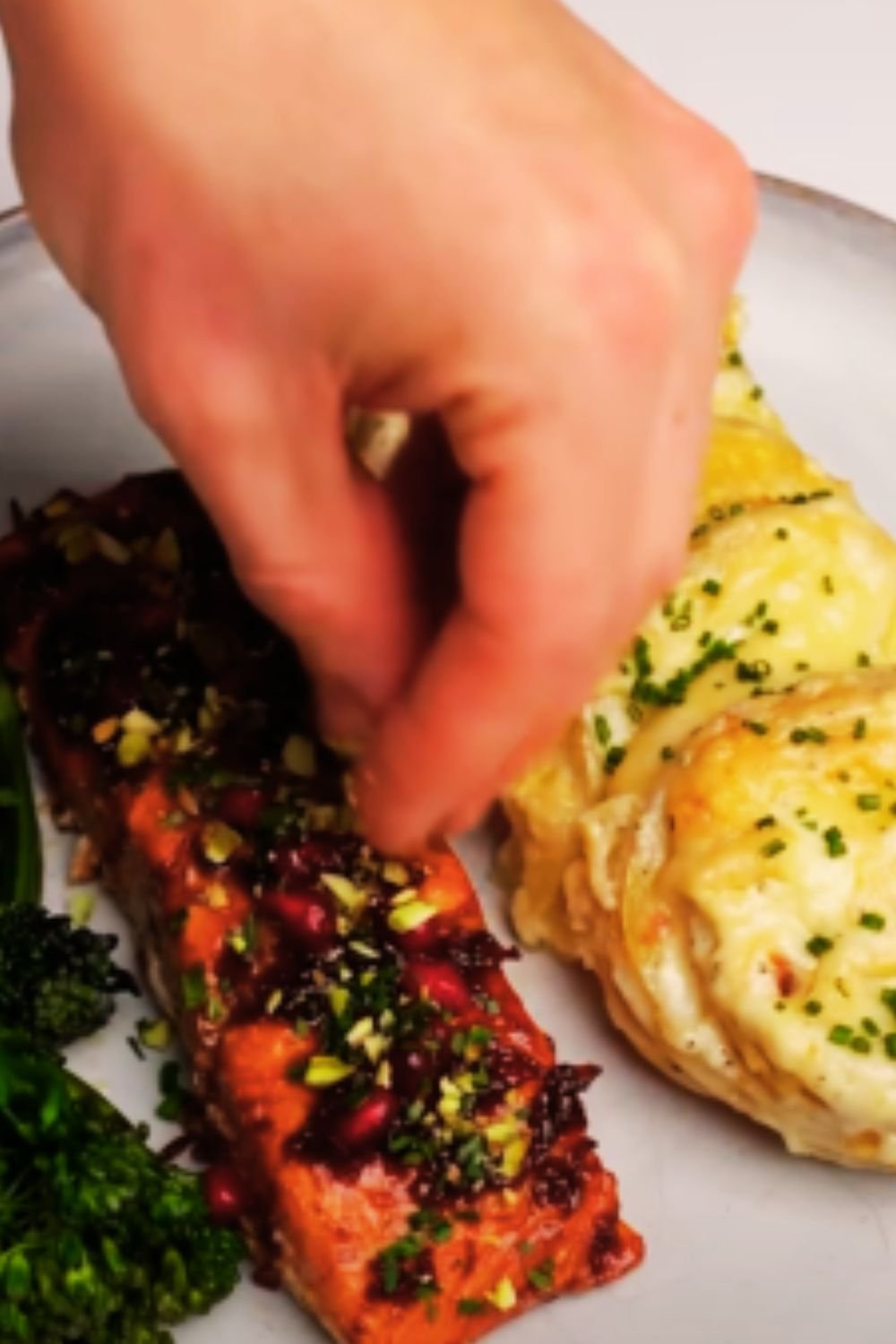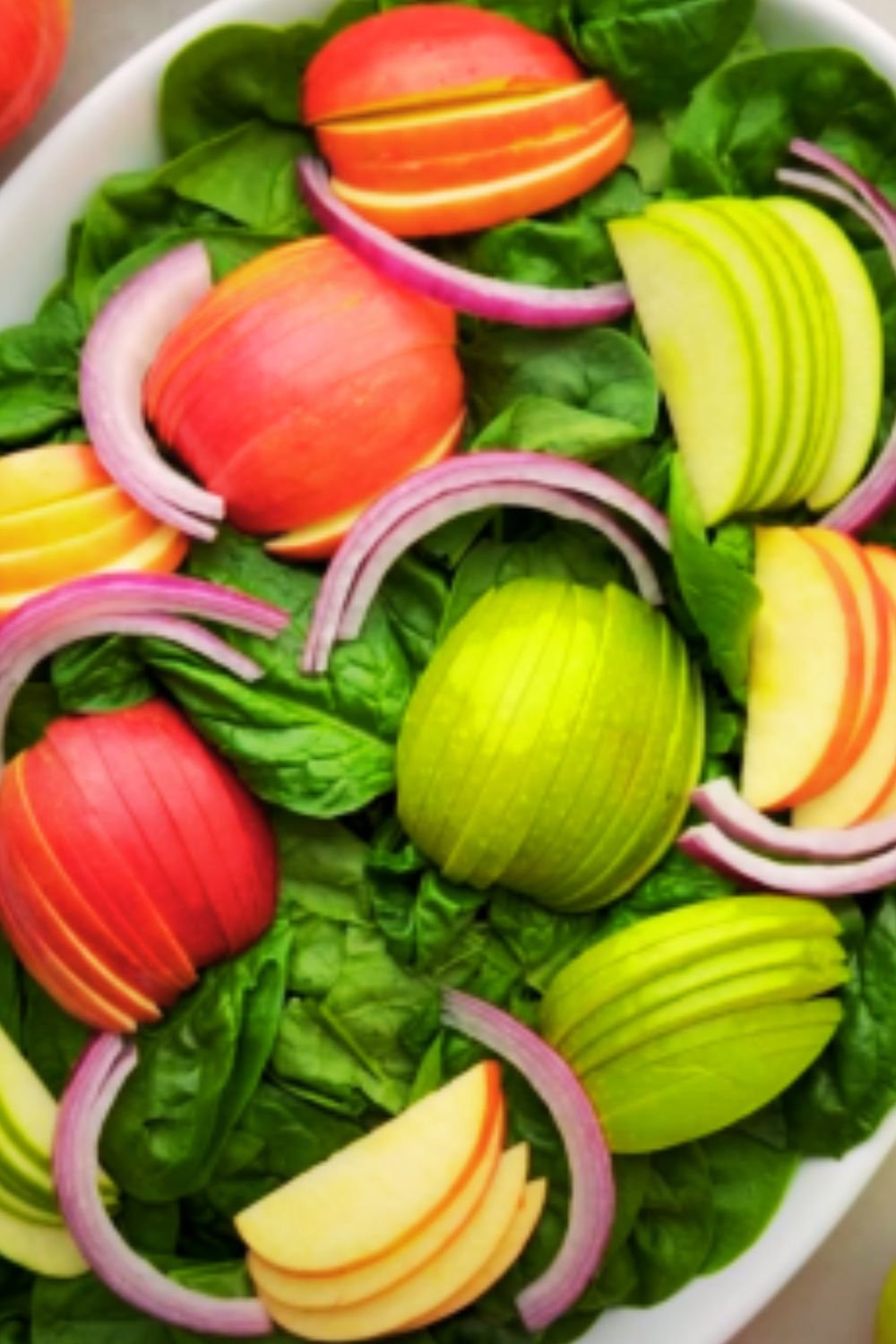There’s something magical about a bubbling dish of potatoes au gratin fresh from the oven. The irresistible aroma of garlic and thyme, the golden-brown crust topped with melted cheese, and those tender slices of potato bathed in a rich, creamy sauce. It’s comfort food at its finest, and I’m excited to share my fool-proof method for creating this impressive side dish that pairs beautifully with almost any main course.
As someone who has prepared this classic French dish for countless family gatherings and dinner parties, I’ve refined my technique over the years to create the perfect balance of creamy, cheesy decadence and subtle flavors that let the humble potato shine. Whether you’re cooking for a special occasion or simply want to elevate your weeknight dinner, this potatoes au gratin recipe is guaranteed to impress.
What Are Potatoes Au Gratin?
Before diving into the recipe, let’s clarify what makes a true potatoes au gratin. The term “au gratin” refers to a French cooking technique where an ingredient is topped with a browned crust, usually using breadcrumbs, grated cheese, egg or butter. In the case of potatoes au gratin (also called “gratin dauphinois” in French cuisine), thinly sliced potatoes are layered with cream and cheese, then baked until golden and bubbly.
Many people confuse potatoes au gratin with scalloped potatoes. Here’s the difference:
- Potatoes Au Gratin: Contains cheese in the sauce and often as a topping; typically made with heavy cream
- Scalloped Potatoes: Traditionally made without cheese, using a roux-based cream sauce
My recipe leans firmly in the au gratin camp, with plenty of cheese both in the layers and on top for that perfect golden crust.
Selecting the Right Potatoes
The foundation of any great au gratin is choosing the right potatoes. I’ve experimented with various types over the years, and here’s what I’ve learned:
| Potato Type | Starch Level | Best Uses | Performance in Au Gratin |
|---|---|---|---|
| Russet | High | Baking, frying, mashing | Good – creates a fluffier texture but may break down more |
| Yukon Gold | Medium | All-purpose, roasting, boiling | Excellent – holds shape while becoming creamy |
| Red Potatoes | Low | Boiling, roasting, salads | Fair – remains too firm and doesn’t absorb cream well |
| Fingerling | Low-Medium | Roasting, salads | Poor – inconsistent size makes for uneven cooking |
| Idaho | High | Baking, mashing | Good – similar to Russet |
For the perfect potatoes au gratin, I always reach for Yukon Gold potatoes. Their waxy yet creamy texture holds up during the long baking time while still becoming tender. They also have a naturally buttery flavor that enhances the final dish. If Yukon Golds aren’t available, Russets make a good substitute, though the texture will be slightly different.
Essential Equipment
Having the right tools makes preparing potatoes au gratin much easier. Here’s what I recommend having on hand:
- Mandoline slicer: For perfectly even, thin potato slices
- 2-quart baking dish: Ceramic or glass works best for even heating
- Heavy-bottomed saucepan: For preparing the cream mixture
- Box grater: For freshly grated cheese (always better than pre-shredded)
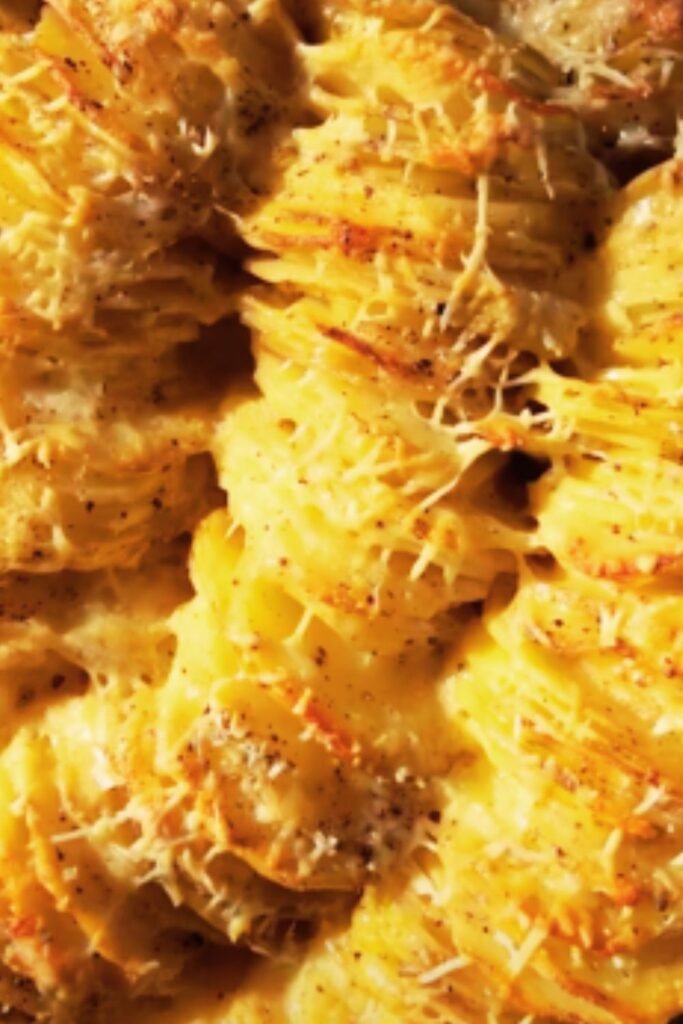
While you can slice the potatoes with a sharp knife, a mandoline creates those picture-perfect, uniform slices that cook evenly and create beautiful layers. Just be sure to use the finger guard—I learned that lesson the hard way!
My Foolproof Potatoes Au Gratin Recipe
Now, let’s get to the heart of the matter—the recipe itself. This serves 6-8 people as a side dish and can be scaled up for larger gatherings.
Ingredients
- 2½ pounds Yukon Gold potatoes, peeled
- 2 cups heavy cream
- 1 cup whole milk
- 3 cloves garlic, minced
- 1 tablespoon fresh thyme leaves (or 1 teaspoon dried)
- 1½ teaspoons kosher salt
- ¾ teaspoon freshly ground black pepper
- ¼ teaspoon freshly grated nutmeg
- 2 cups Gruyère cheese, freshly grated (divided)
- 1 cup Parmigiano-Reggiano, freshly grated (divided)
- 2 tablespoons unsalted butter, cut into small pieces
Step-by-Step Instructions
- Prepare the oven and baking dish: Preheat your oven to 350°F (175°C). Butter a 2-quart baking dish generously.
- Slice the potatoes: Using a mandoline set to approximately 1/8-inch thickness, carefully slice your peeled potatoes. Immediately place them in a large bowl of cold water to prevent browning while you prepare the other components.
- Prepare the cream mixture: In a medium saucepan over medium heat, combine the heavy cream, milk, minced garlic, thyme, salt, pepper, and nutmeg. Bring to a gentle simmer (do not boil), stirring occasionally. Once it begins to simmer, remove from heat.
- Drain and dry the potatoes: Thoroughly drain the potato slices and pat them dry with clean kitchen towels. Wet potatoes will dilute your carefully seasoned cream mixture.
- Begin layering: Arrange one-third of the potato slices in the bottom of the prepared baking dish, slightly overlapping them. Pour one-third of the cream mixture over the potatoes, then sprinkle with one-third of the combined cheeses (keep about ½ cup of cheese reserved for the final topping).
- Complete the layers: Repeat the layering process twice more with the remaining potatoes and cream mixture. For the final layer, pour the remaining cream mixture, but hold back on the last portion of cheese.
- Dot with butter and cover: Distribute the small pieces of butter over the top layer. Cover the dish tightly with aluminum foil.
- Initial baking: Bake covered for 45 minutes.
- Add final cheese and brown: Remove the foil, sprinkle the remaining cheese over the top, and continue baking uncovered for another 30-40 minutes, until the top is golden brown and bubbling, and the potatoes are completely tender when pierced with a knife.
- Rest before serving: Allow the potatoes au gratin to rest for 15 minutes before serving. This crucial step allows the layers to set and the flavors to meld together.
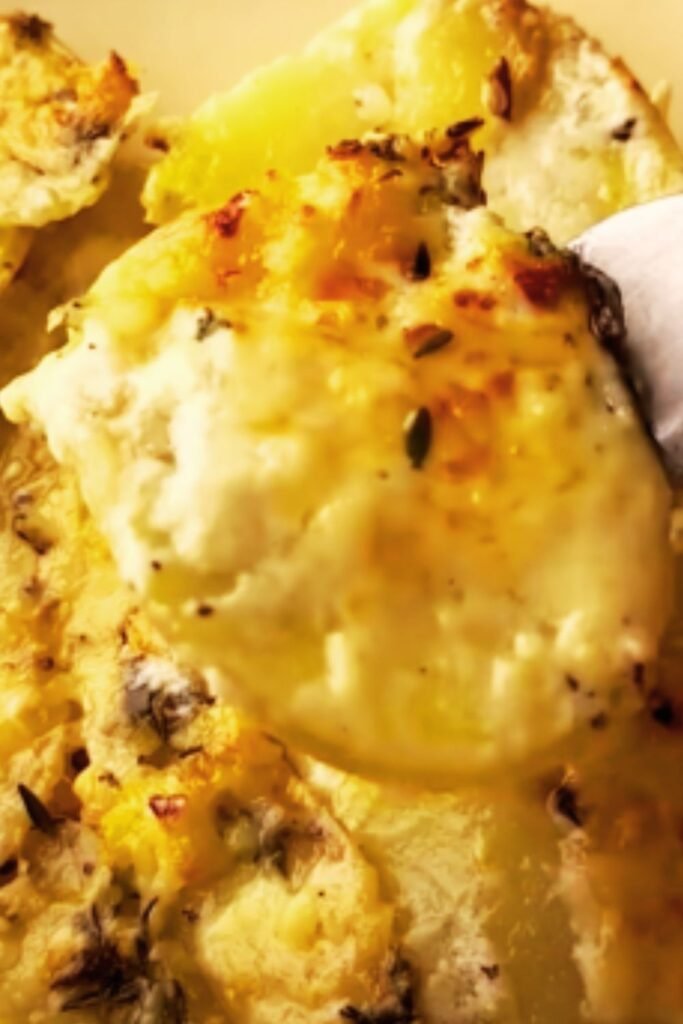
Common Mistakes to Avoid
Through years of making this dish, I’ve encountered (and made) several common mistakes. Here’s how to avoid them:
- Slicing potatoes too thick: Thick potato slices won’t cook through properly, leaving you with undercooked, crunchy layers. Aim for 1/8-inch thickness.
- Skipping the soaking step: Soaking sliced potatoes in cold water removes excess starch, preventing the dish from becoming gluey.
- Using pre-shredded cheese: Pre-packaged shredded cheese contains anti-caking agents that prevent proper melting. Always grate your cheese fresh.
- Seasoning inadequately: Potatoes need plenty of seasoning. The cream mixture should taste slightly too salty when sampled alone, as the potatoes will absorb much of the salt during baking.
- Rushing the baking process: Potatoes au gratin requires slow, patient baking to achieve that perfect tender texture and flavor infusion.
- Skipping the resting period: Cutting into the dish straight from the oven results in a runny sauce that hasn’t had time to set.
Variations to Try
While the classic recipe is perfect as is, here are some delicious variations I’ve developed over the years:
Potatoes Au Gratin with Caramelized Onions
Add a layer of caramelized onions between your potato layers for a sweet and savory twist. To make them, thinly slice 2 large onions and cook slowly in 2 tablespoons of butter over low heat for about 30-40 minutes until deeply golden and sweet.
Herb-Infused Potatoes Au Gratin
Create an herb-infused cream by adding a bouquet garni (a bundle of fresh herbs like thyme, rosemary, and bay leaf tied together) to your cream mixture as it heats. Remove before assembling the dish. This imparts a subtle, aromatic quality to the final dish.
Mushroom and Truffle Potatoes Au Gratin
For a luxurious version, add a layer of sautéed mushrooms (wild mushrooms work beautifully) between potato layers and include a teaspoon of truffle oil in the cream mixture. This creates an earthy, umami-rich version perfect for special occasions.
| Variation | Additional Ingredients | Prep Notes | Best Served With |
|---|---|---|---|
| Classic | None | As described in main recipe | Roasted meats, steaks |
| Caramelized Onion | 2 large onions, butter | Caramelize onions for 30-40 minutes first | Grilled chicken, pork chops |
| Herb-Infused | Fresh herb bouquet | Simmer herbs in cream, then remove | Fish, lamb |
| Mushroom & Truffle | Wild mushrooms, truffle oil | Sauté mushrooms before adding | Beef tenderloin, roast duck |
| Smoky Bacon | 6 slices crispy bacon, smoked Gouda | Replace some Gruyère with smoked Gouda | Barbecue, grilled meats |
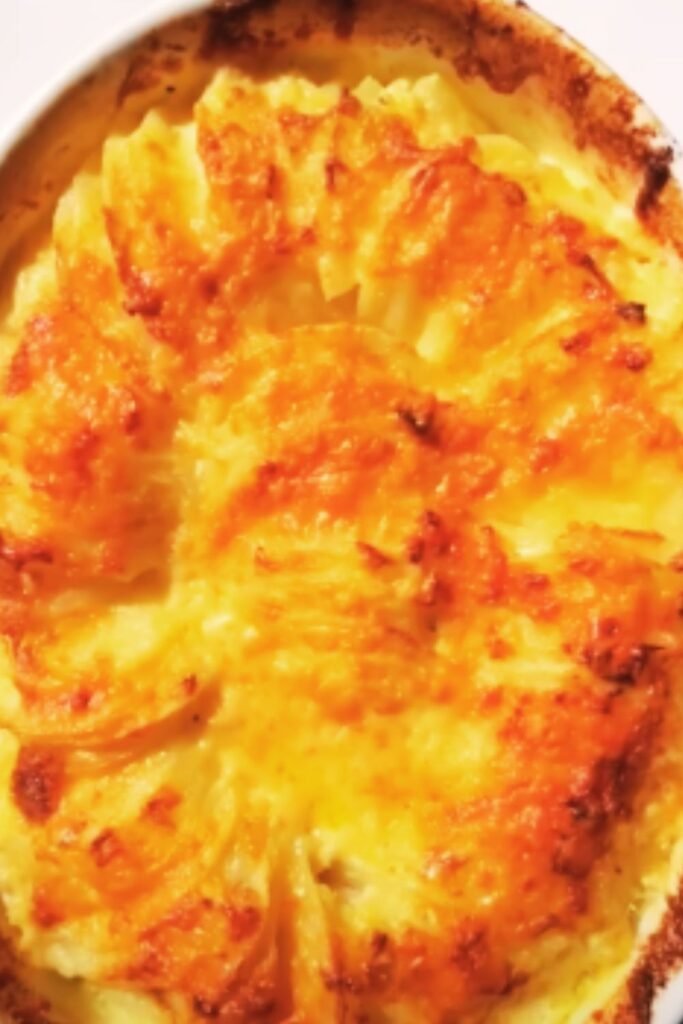
Make-Ahead and Storage Tips
One of the things I love about potatoes au gratin is that it can be prepared in advance, making it perfect for entertaining:
Make-Ahead Instructions:
- Partially bake option: Assemble the dish completely, cover with foil, and bake for 30 minutes. Cool completely, then refrigerate for up to 2 days. When ready to serve, bring to room temperature and bake covered for 15 minutes, then uncovered for 30-40 minutes until hot and bubbly.
- Prep-ahead option: Slice the potatoes and store them in cold water in the refrigerator for up to 24 hours. Prepare the cream mixture separately and refrigerate. Assemble and bake when ready.
Storage and Reheating:
- Refrigerator: Leftover potatoes au gratin will keep in an airtight container for up to 4 days.
- Freezer: While possible to freeze, the texture suffers somewhat. If freezing, do so before the final baking step. Thaw completely in the refrigerator before baking.
- Reheating: For best results, reheat in a 325°F oven covered with foil until heated through (about 20-30 minutes). Individual portions can be reheated in the microwave, though the texture won’t be quite as good.
Nutritional Information
For those watching their nutritional intake, here’s the approximate nutritional information per serving (based on 8 servings):
| Nutrient | Amount per Serving |
|---|---|
| Calories | 425 |
| Total Fat | 32g |
| Saturated Fat | 20g |
| Cholesterol | 115mg |
| Sodium | 580mg |
| Total Carbohydrates | 25g |
| Dietary Fiber | 2g |
| Sugars | 3g |
| Protein | 12g |
| Calcium | 35% DV |
| Vitamin D | 10% DV |
| Potassium | 15% DV |
While this is definitely an indulgent dish, it’s meant to be enjoyed as a special treat alongside proteins and vegetables for a balanced meal.
Serving Suggestions
Potatoes au gratin makes a magnificent accompaniment to many main courses. Here are my favorite pairings:
- Beef: Prime rib, beef tenderloin, or a simple steak
- Poultry: Roast chicken, turkey, or duck
- Pork: Roasted pork loin or grilled pork chops
- Lamb: Rack of lamb or lamb shanks
- Seafood: Salmon or scallops
- Vegetarian: Paired with roasted vegetables and a simple salad
For a complete menu, I recommend:
- Herb-crusted roast beef
- Potatoes au gratin
- Roasted asparagus with lemon
- Fresh green salad with vinaigrette
- Sparkling water with lemon
This creates a balanced, impressive meal suitable for special occasions or Sunday dinner.
Why This Recipe Works
After years of testing and refining, I can confidently say this recipe works because:
- The ratio of cream to milk: Using a combination creates the perfect consistency—not too heavy, not too light.
- Flavor infusion: Simmering the herbs and seasonings in the cream mixture before assembly ensures every bite is flavorful.
- Dual-stage baking: The covered baking period cooks the potatoes thoroughly, while the uncovered period creates that signature golden crust.
- The cheese blend: Gruyère provides excellent melting properties and nutty flavor, while Parmigiano-Reggiano adds savory depth and helps create the perfect crust.
- Proper potato selection: Yukon Golds strike the ideal balance between maintaining their shape and becoming creamy when baked.
Frequently Asked Questions
Q: Can I make potatoes au gratin ahead of time?
A: Absolutely! You can assemble the entire dish up to 24 hours in advance and refrigerate it covered. When ready to bake, let it sit at room temperature for 30 minutes, then follow the baking instructions, adding about 10-15 minutes to the covered baking time.
Q: What’s the difference between scalloped potatoes and au gratin?
A: The main difference is cheese. Traditional scalloped potatoes are made with a cream sauce but no cheese, while au gratin potatoes include cheese both in the layers and on top. Some scalloped potato recipes also use a flour-based sauce, while au gratin typically uses straight cream.
Q: Can I use different cheeses?
A: Yes! While Gruyère and Parmigiano-Reggiano create the classic flavor, you can substitute with other good melting cheeses. Comté, Emmental, or even a sharp cheddar can work well. For the topping, any hard, grateable cheese that browns nicely will work.
Q: My potatoes aren’t cooking evenly. What am I doing wrong?
A: Uneven cooking usually results from inconsistent slicing thickness. A mandoline ensures uniform slices that cook at the same rate. If you’re using a knife, take extra care to maintain consistent thickness. Also, make sure your potatoes are well-arranged in even layers.
Q: Can I make this dish lighter?
A: For a lighter version, you can substitute half-and-half for the heavy cream. You can also use a mixture of whole milk and Greek yogurt. The texture won’t be quite as luxurious, but it will still be delicious. I don’t recommend using low-fat milk, as the sauce may separate during baking.
Q: My au gratin seems curdled. How can I prevent this?
A: Curdling usually happens when the dairy is heated too quickly or at too high a temperature. Always heat your cream mixture gently, never allowing it to boil. Adding a tablespoon of flour to the cream mixture can also help stabilize it.
Q: What if I don’t have a mandoline?
A: While a mandoline creates the most consistent results, you can use a food processor with a slicing disc or simply a sharp chef’s knife. If using a knife, take your time and try to maintain a consistent thickness of about 1/8 inch for each slice.
Q: How do I know when the potatoes are fully cooked?
A: Insert a knife or skewer into the center of the dish. It should slide easily through the layers with no resistance. If there’s any firmness, continue baking for another 10-15 minutes.

Final Thoughts
Potatoes au gratin may seem like a fancy, complicated dish, but with this straightforward approach, it’s actually quite achievable for home cooks of any skill level. The key is selecting quality ingredients, taking your time with the preparation, and allowing the dish to bake slowly to develop those complex flavors and perfect texture.
What I love most about this recipe is how it transforms humble potatoes into something truly special. There’s a reason this dish has been a staple of French cuisine for generations—it’s simply magnificent. Whether served alongside a holiday roast or as part of a simple Sunday dinner, these creamy, cheesy potatoes never fail to elicit sighs of contentment from around the table.
I encourage you to try this classic version first, then experiment with the variations to find your own favorite twist. Once you master potatoes au gratin, you’ll have a go-to side dish that’s sure to impress for years to come.
Remember, cooking is about pleasure—both in the making and the eating—so enjoy the process and the delicious results!
